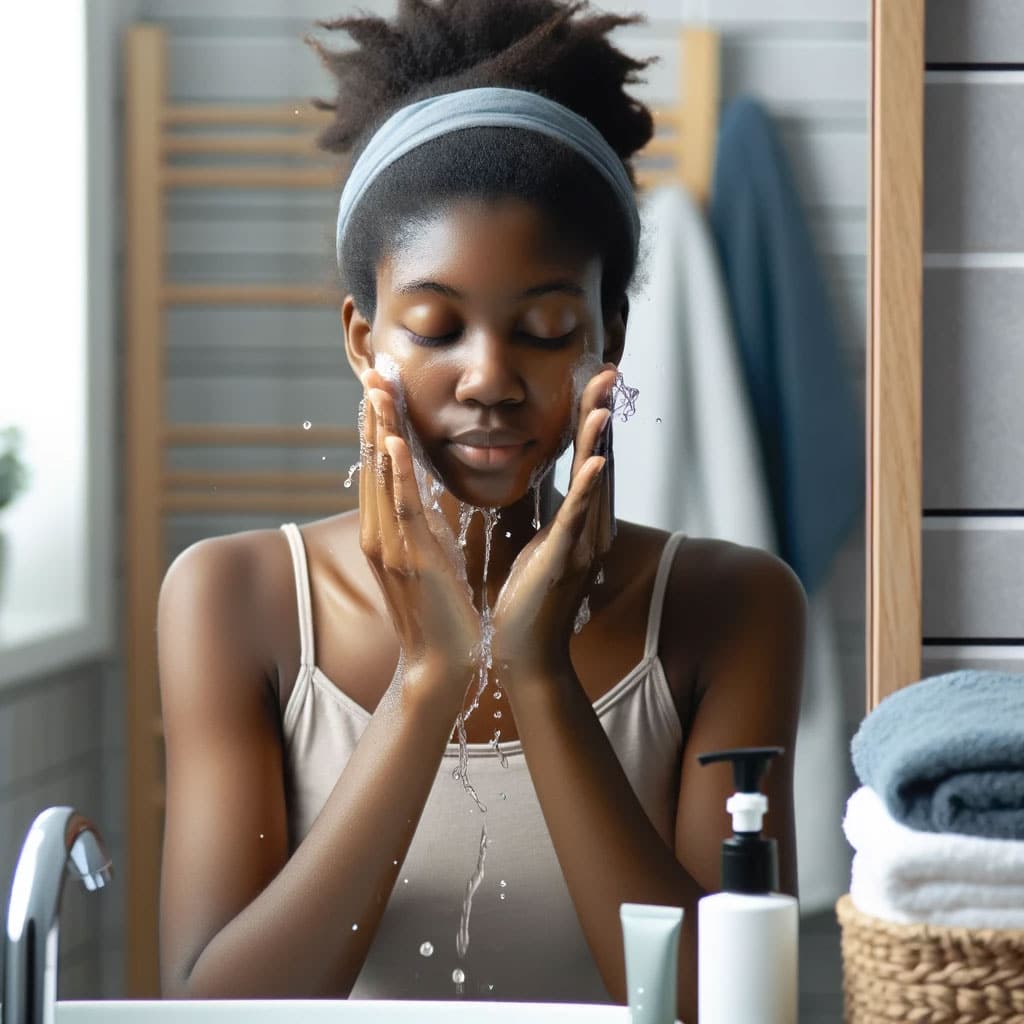Understanding the various types of acne scars and their severity is crucial in determining the most effective treatment options.
Understanding Acne Scars

Causes
Acne scars result from inflammation within the dermal layer of the skin due to acne. They occur when the acne pore swells, causing a breakdown in the pore wall. In cases where the contents of blemishes spill into the surrounding tissue, deeper scars can form.
While acne can affect people of all ages and skin types, the severity of scarring depends on various factors, including genetics and skincare habits.
Here’s a list of common causes for acne scarring:
- Inflammation: Severe acne with cysts or nodules can lead to inflammation, damaging surrounding tissue, and eventually scarring.
- Picking or squeezing acne: This can increase inflammation and risk of scarring.
- Delayed treatment: Prolonged acne can lead to a higher risk of scarring.
Types
Several types of acne scars can be classified based on their appearance. Here’s a table summarizing the main types:
| Type | Description |
|---|---|
| Ice pick | Narrow, deep, and V-shaped scars; typically result from severe cases of acne. |
| Boxcar | Wide, U-shaped depressions with sharp edges; can vary in depth. |
| Rolling | Wider, shallow depressions with rounded edges that create a wave-like appearance; often result from long-term acne. |
| Keloid | Thick, raised scars result from an overproduction of collagen during the healing process. |
| Hypertrophic | Similar to keloid scars but smaller; more common on chest and back. |
Each type of scar may require different treatment approaches.
Assessing the Severity of Acne Scars
Assessing the severity of acne scars is a crucial step in determining the most effective treatment plan for each individual. This process typically begins with a thorough physical examination, during which the scars are classified by their morphology and overall severity1.
Several factors contribute to the severity of acne scarring, such as the grade of acne and the individual’s response to inflammation2. Inflammatory cell infiltrates are found in 77 percent of atrophic scars, suggesting that a heightened inflammatory response may lead to more severe scarring2.
To further categorize acne scars, clinicians often use the following classification system:
- Atrophic scars: These are depressed scars that form due to a loss of collagen during the healing process.
- Hypertrophic scars: These raised scars result from an overproduction of collagen during the healing process.
- Keloid scars: Similar to hypertrophic scars, keloids are raised and form due to excessive collagen production. However, they typically extend beyond the boundaries of the original wound.
Additionally, atrophic acne scars can be subdivided into three primary types: ice pick, rolling, and boxcar scars3. Ice pick scars are characterized by narrow, deep indentations while rolling scars have gently sloping edges and create an undulating skin surface. Boxcar scars, on the other hand, have well-defined, angular edges and a broad, flat base.
To systematically evaluate the severity of acne scarring, patient-reported outcome measures such as the self-assessment of clinical acne-related scars (SCARS) and the facial acne scar quality of life (FASQoL) tools can be utilized4. These tools have been specifically developed for measuring the severity of facial atrophic acne scarring and adhere to the Food and Drug Administration guidance methodology.
Footnotes
- “Evaluation of Acne Scars: How to Assess Them and What to Tell … – PubMed” ↩ ↩2
- “Acne Scarring—Pathogenesis, Evaluation, and Treatment Options” ↩ ↩2
- “Acne Scarring Management: Systematic Review and Evaluation … – Springer” ↩
- “New Patient-Oriented Tools for Assessing Atrophic Acne Scarring” ↩
Treatments for Acne Scars
When it comes to treating acne scars, there are several options available. This section will focus on two main categories: topical treatments and clinical procedures. The choice of treatment depends on the type of scar, the severity, and potential side effects. It is essential to consult with a dermatologist for a personalized treatment plan.
Topical Treatments
1. Topical Retinoids: These vitamin A derivatives help promote skin cell turnover and reduce the appearance of superficial scars. They are available in various strengths, both over-the-counter and prescription-based. Retinol, tretinoin, and tazarotene are examples of topical retinoids.
It is crucial to apply these products at night and use sunscreen during the day due to photosensitivity.

2. Alpha Hydroxy Acids (AHAs): AHAs, such as glycolic acid and lactic acid, can help exfoliate the skin, reduce hyperpigmentation, and improve skin texture. They are available in various skincare products like cleansers, toners, and creams.
3. Silicone Gels: Applying silicone gel sheets or topical silicone gel can help soften, flatten, and reduce the redness of raised acne scars, especially hypertrophic and keloid scars.
Clinical Procedures
1. Chemical Peels: These treatments involve applying a chemical solution to the skin, causing the top layer to peel off and reveal fresh, new skin. They can help improve superficial acne scars, hyperpigmentation, and skin texture.
Chemical peels vary in strength and depth, and a dermatologist can recommend the appropriate peel for your skin type and concerns.
2. Dermabrasion: Dermabrasion is a procedure where the top layer of skin is removed using a rapidly rotating brush or other device. This treatment can help remove surface scars and make deeper scars less noticeable. However, it may cause scarring and changes in skin color and is typically reserved for more severe scarring.
3. Microneedling: This technique involves using a device with tiny needles to create microscopic punctures in the skin. This action stimulates collagen production, which could improve the appearance of atrophic acne scars.
Microneedling is generally safe for most skin types, and multiple sessions may be required to achieve desired results.
4. Laser Resurfacing: Laser treatments can remove damaged skin layers, stimulate collagen production, and improve the appearance of acne scars. Different types of lasers have specific applications, and a dermatologist can recommend a suitable laser treatment depending on scar type and skin tone.

Prevention via Skin Care Regime
Developing a proper skincare regime is essential for preventing acne scars. This can be achieved by following a few simple steps to maintain healthy and clean skin.
Step 1: Cleanse – Gently cleanse your skin twice a day using a mild cleanser suitable for your skin type. This helps remove excess oil, dirt, and makeup that can cause acne breakouts and lead to scarring. Avoid using harsh soaps or scrubs, as they can irritate the skin and worsen acne.

Step 2: Exfoliate – Exfoliation is important to remove dead skin cells and unclog pores that can contribute to acne breakouts. It would help if you exfoliate one to two times a week using a gentle exfoliating product. Be cautious not to over-exfoliate, as this can also irritate the skin and cause acne.
Step 3: Moisturize – You should always moisturize after cleansing regardless of skin type. Choose a non-comedogenic moisturizer that won’t clog your pores. Keeping your skin hydrated can reduce the risk of acne breakouts and subsequent scarring.
Step 4: Sun protection – Shielding your skin from the sun is important in preventing acne scars. According to Healthline, wearing a broad-spectrum sunscreen with at least SPF 30 is crucial for protecting your skin from harmful UV rays that can exacerbate acne and make existing scars more noticeable.

Step 5: Topical treatments – Consider using over-the-counter acne treatments that contain salicylic acid, benzoyl peroxide, or retinoids, which can help prevent breakouts and reduce the risk of scarring. Be cautious not to overuse these treatments, as they can cause skin irritation.
In addition to these steps, it’s important to avoid picking or squeezing pimples, as this can lead to inflammation and increase the risk of scarring. Seeking professional advice from a dermatologist is also helpful in determining the best skin care regime for your unique skin type and concerns.
Footnotes
- Healthline. “Acne Scars: Treatment, Removal, Best, and More.” Healthline. ↩
Emotional and Psychological Implications
Acne scars can have a significant impact on an individual’s emotional and psychological well-being. Many people with acne scars may experience a decrease in self-esteem and confidence, leading to problems in different aspects of their lives, including social interactions and personal relationships.
The psychological effects of acne scars are diverse and may include feelings of embarrassment, depression, anxiety, and even stigmatization. In a study, it was found that 32.9% of participants reported receiving negative comments due to their acne scars, and 12.6% felt considerably upset about their scars. Additionally, 8.3% reported being verbally or physically abused because of their scars regularly1.
The connection between acne and mental health is referred to as psychodermatology. This field of study aims to better understand the relationship between skin disorders, such as acne vulgaris, and psychological factors. Psychodermatology research has shown that acne has a significant psychological impact, regardless of its severity or frequency2.
Furthermore, acne scarring can prolong existing negative thought processes that occur during the phase of active acne. Acne scarring has been linked to various psychological impairments, such as:
- Low self-esteem
- Negative body image
- Avoidant social behaviors3
It is essential to address both the physical and psychological aspects of acne scars when seeking treatment. Various therapeutic approaches can be taken, including:
- Topical treatments: creams, gels, or ointments containing active ingredients that can help reduce the appearance of acne scars.
- Dermatological procedures: such as microdermabrasion, chemical peels, or laser therapy, to reduce the visibility of the scars.
- Psychological support: counseling, therapy, or support groups focused on coping with the emotional impact of acne scars.
Footnotes
Beyond the Surface: A Deeper Look at the Psychosocial Impacts of Acne … ↩

